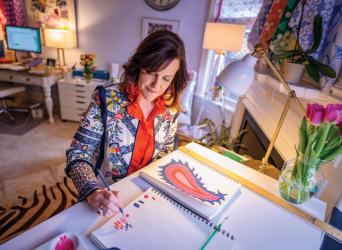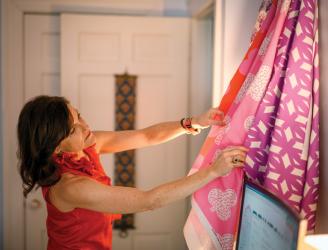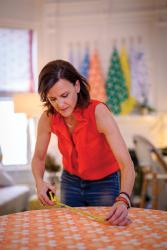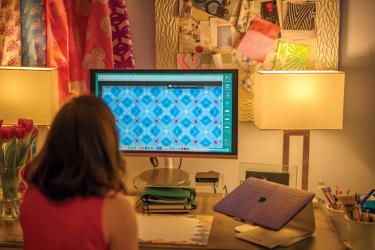Every house has a story. Suzanne Miller decided to add to hers by creating her home décor business, The Storied House, a boutique design studio creating textiles in colorful, original designs. Her hope was for it to be a source for design and sustainability in St. Louis. “About four years ago, I was feeling a little burnt out with what I was doing,” Miller says. “I didn’t necessarily want to do interior design, but I knew I wanted to make a product. I took a class at Central St. Martins in London, and it opened up a whole new world.”
The Storied House specializes in creating joyful fabric designs that assist customers in expressing their individuality in an environmentally-conscious fashion.
Growing up around artists inspired her to see life in a different way. Even though she never took any classes in sewing, she says she did a little work with needlepoint in the past. “My mother is a painter,” says Miller. “She also loves interior design. Whenever we were traveling, we used to visit historical homes or museums. My grandmother liked to sew, and my aunt on my dad’s side was a painter as well.”
One way Miller found a way of life was capturing her reality through a camera. Photos helped her develop an eye for color and design in a different way. Capturing what she saw allows her to show design in a tactile way. “My mom was more subtle with color,” she says. “My aunt did very bright colors. I think it’s more of listening to how you feel. Colors kind of pep you up, so I keep going in that direction.”
A world traveler, Miller has discovered new ways of life and met new people by exploring. For her honeymoon, she spent three weeks in South Africa where she was drawn to the bright colors used there. “They have a very big European influence and a sophisticated design with the Indigenous art,” Miller notes. She uses her travels for inspiration when designing original, colorful fabrics.
This year, Miller is opening a design page on Spoonflower, a digital printing company, that will allow her to print designs faster and make them more eco-friendly.
“If I have someone order three yards, I can custom order three yards. Before, you had to have a minimum of 50 yards. A lot of fabric would go to waste if you didn’t sell it. You couldn’t do this five or six years ago.”
Spoonflower also allows customers to choose a design where they can see what it would look like on other items like pillows, napkins or duvets. “When I was decorating my house on social media, there would be a set design and there wasn’t a lot of variety,” Miller says. “This puts a lot of power to the consumer.”
Miller says she is also working on expanding her brand to reach bigger partners and that she would not be where she is today without her experiences over the years. “I doubt I would be as exposed as I am now without all the art, textile and fashion museums I have been to,” she says.













